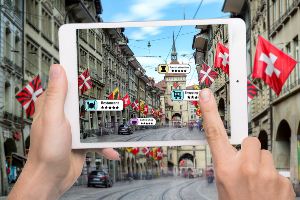Augmented reality – The next big thing for HR?

We live in a futuristic present, where technologies once considered restricted to the realms of science fiction are now penetrating our daily lives – automation, robotics, virtual reality (VR) and cloud computing to name but a few.All of these have changed, or will change, the way we live and work. Another that looks set to have a huge impact is augmented reality (AR), says Hannah Jeacock, research director at MHR.
What is AR?
As the name suggests, AR augments, or enhances, reality. So when looking through a set of AR goggles, you see your regular reality but with digital features layered over it, the result being a seamless blend between the real and the virtual.
What is AR used for?
AR exploded into the public focus with the 2016 cultural phenomenon Pokémon Go, an application where gamers use their smartphones or tablets to see, and then catch, virtual Pokémon characters overlaid on our real-world landscape. Since then, more and more AR software has hit the market, with increasingly practical applications. Here are just a few examples.
- Shopping
Shoppers can view products superimposed onto real environments, allowing them to see how a new sofa would look in their actual living room. Similar apps allow users to try out new clothes, or even see what they would look like with a new tattoo.
- Navigation
AR navigation apps work together with a device’s GPS and camera to display your selected route over the real environment, complete with street names and distances.
- Sightseeing
Similarly, AR sightseeing apps allow tourists to view information about buildings, landmarks and historical sites through their phone’s display. This information pops into view as the user moves from place to place.
- Manual work
There are plenty of practical applications in the world of manufacturing, particularly in repair and maintenance work. For example, using a headset or goggles, a mechanic can be guided through a technical process with AR imagery and information layered over or around the real object they are working on.

Hannah Jeacock
It is easy to see how AR could soon replace brochures, maps, guidebooks, and training manuals, completely revolutionising the way we consume products and experience the world. It is no wonder that Greg Jones, director of VR and AR at Google, commented, “at some point we’re going to look back and think ‘how did we not have a digital layer on the physical world?’”
AR in the workplace
AR also has the potential to revolutionise our working lives, changing how we think about office spaces and equipment forever.
Most of us still commute to an office every day, which can be a time-consuming and stressful experience. AR has the potential to turn any space into your own customisable workspace, complete with digital notes, folders and files – even a digital photo of your loved ones. This would give you access to all the information and tools that you would typically find in an office, but wherever and whenever you need them.
Instead of working on a flat, stationary, two-dimensional screen, your workspace would be a customisable three-dimensional space, where objects and information are manipulated with gestures rather than hardware. All you would need is an AR headset.
AR could also transform the way we advertise brands and share information. Imagine if your organisation had an AR stand at a conference – how engaging would that be for potential customers? How much more interesting and fun would meetings be if we used AR to present information instead of slides on a projector?
What about HR?
AR could have a huge impact on HR as well, transforming long-established processes into something engaging and exciting.
Take on-boarding, for example. Many organisations approach this critical process from a purely administrative angle – new starters must be inducted into the organisation, receiving vital information about the organisation, key people and places. But in many cases this can be a dull affair that feels more like a box-ticking exercise.
AR could transform the on-boarding experience into something fun and interactive – imagine taking an AR tour of your office, where information about key places, company history or your new colleagues pops into view as you go from place to place. How much more effective and enjoyable would this be than sitting in a room staring at a flipchart?

Greg Jones
We could also see the same sort of transformation in learning and development (L&D). Where traditional approaches to L&D revolve around imparting information in a classroom-style environment, complete with teacher and learners, AR could truly immerse learners in a ‘hands-on’ world of relevant information, presented in a way that enhances the learning experience.
AR brings real benefits
AR is more than just a gimmick and can help organisations engage and retain their talent. More effective learning and development means a continuously upskilled workforce.
AR is a perfect example of how technology can enhance human processes. Rather than handing over control to tech, we can harness its power to do what we do better, resulting in a more efficient, successful and enjoyable way of working.
The author of this blog is Hannah Jeacock, research director at MHR
About the author
Hannah Jeacock is research director at MHR. Having worked in the software industry for 14 years, Hannah has a host of experience implementing and delivering a variety of software solutions.
Comment on this article below or via Twitter @IoTGN
